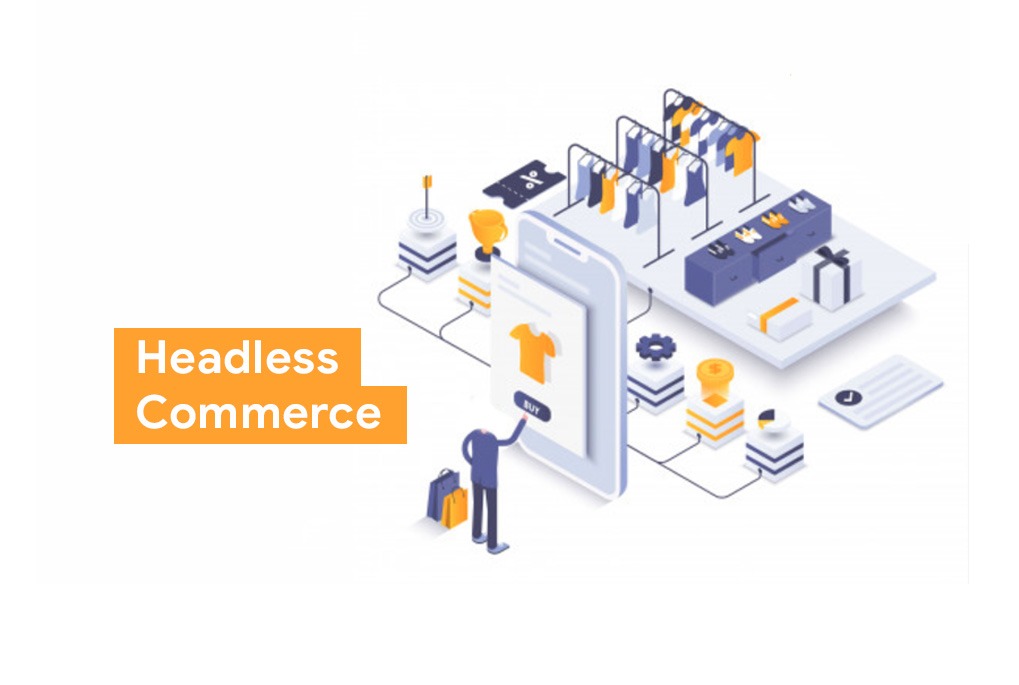
- Products
- Solutions
- Learn
- Partner
- Try Now
Headless Commerce is probably the most discussed and least understood buzzword since Big Data. And like a wise man once said everyone discusses Headless but nobody really understands it.
Learn what you’ll find below in the blog:
- What is Headless Commerce?
- How does it work?
- Architecture of headless commerce
- Traditional vs Headless Commerce
- Advantages of headless commerce
- Challenges of headless commerce
- Who should go for headless commerce?
The digital landscape is more focused on the consumer than ever before. With the changing needs of consumers, they want full control over how and where they shop. Consumers these days don’t go to a shop or a website or even an app looking for something to buy. They want to shop on the go. This is where Headless Commerce comes into play.

What is Headless Commerce?
In Headless Commerce, the front-end is separate and independent of the backend. They are very loosely coupled. It is very easy to make changes in customer experience using the front-end without changing or tweaking the backend interface.
Consumers are getting used to consuming content and buying from various sites rather than legacy platforms that are now struggling to keep up with consumer demand. D2C is amidst exponential growth globally which has generated the need for a more independent form of commerce, Headless Commerce.
Simply put headless commerce is the modern-age architecture that helps to eliminate the single point of failure on your website/app. It is designed to be more resilient and ensures a rich customer experience. What this means to you and your business is that it will help your business consistently with high conversion rates at high traffic levels.
In headless you have the freedom to choose the back-end and front-end components that are most suitable for your needs. Using the headless approach businesses can scale and change customer experience without disrupting the workflow of the backend processes.
According to Dirk Hoerig, CEO of Commerce Tools
“Headless commerce platform provides companies with the full potential of best-in-class online retail regardless of the boundaries to specific touchpoints and ensures a great user experience. A truly headless commerce platform provides robust commerce capabilities such as shopping cart, product information management, promotions, and merchant support irrespective of the customer entry point. On top of that, a headless Commerce system can be easily connected – via APIs – to any customer experience front-end.”
How does it Work?
The backend layer of the headless platform is constructed in modules that include services like customer relationship management, payment processing, cart management, etc.
The front-end layer of the headless commerce architecture is very flexible to design. Mostly it is a custom-built presentation layer that keeps adapting according to the needs of the customers and their changing buying behavior.
Architecture of Headless Commerce
It is a subset of decoupled commerce. It aims to push content to any kind of platform through APIs. Front-End and Back-End are separate and work as 2 individual platforms that are interlinked via APIs.
In the Headless approach, the focus is on background processes that make the data available to the front-end modules via APIs. However, headless is not only making data available to separate layers it requires a few additional resources.
It uses a separate inventory management system that takes care of the backend database. Some of the backend systems include customer relationship management systems, payment processing systems, cart management systems, etc.
Traditional Commerce vs Headless Commerce
There are 3 major differences between Traditional and Headless Systems
| Differentiators | Traditional Commerce | Headless Commerce |
|---|---|---|
| Front-End Development | 1. Design Constraints. 2. The time to edit the database, code, and platform is massive. | 1. No design constraints, just make a simple API call. 2. Need to build a front-end presentation from scratch. |
| Customization and Personalization | Pre-Defined experiences for both users and admins. | Create your own experience for both users and admins |
| Flexibility and Adaptability | Front-End is tightly coupled with backend which means there’s a little room for customization. | Endless room for customization and changes can be made on the fly. |
The biggest advantage and drawback of traditional commerce are that everything is tightly packed together.
The back-end of the traditional systems not only stores the content but the code for the layout and other plugins required by the front-end. Due to this the amount of customization that can be done to personalize the system gets limited.
Advantages
- Gives you the ability to move lightning fast.
Since the backend is not connected with the frontend very tightly and the only communication with the frontend is through APIs. It gives you the ability to make changes and innovate at a very rapid pace. This helps you adapt to the changing consumer technologies and trends, - Gives you more room for customization and personalization.
Many traditional commerce platforms are very tightly coupled. This restricts you from providing a custom experience to your customers. Whereas Headless solution makes it easier and builds more adaptive and responsive platforms. - Gives your developer independence to use any programming language and framework.
Since the headless solution is built upon APIs it gives the developers the independence of choosing any programming language or framework. - Can be Cheaper.
These solutions can be cheaper when run to scale For Example During a scale you might need to scale your checkout, cart, and payment processing systems very rapidly to accommodate the high level of traffic and scale down at quieter times. - Integrate with any Tool.
The ability to seamlessly integrate different tools is a secret to a successful strategy to grow. Headless technology allows you to integrate different tools together using APIs. It also makes it easier to swap out or update the set of technologies by changing the overall tech stack. - Makes Optimization Easier.
With Legacy platforms, it is difficult to make changes and adapt to new technologies and consumer preferences. Whereas this problem is solved with headless solutions using APIs, makes the process of adapting to new consumer preferences easier and faster. - Ability to add transactional functionality to existing user interfaces.
You can add the transactional ability to your content sites. A separate user interface lawyer can be added to the backend setup without changing the overall technology stack. - Helps you improve website performance.
With independent front-end and back-end. You can make your platform more responsive and faster.
Challenges
- Multiple integrations with independent applications: Integrating with different technologies can be a cumbersome task.Even with the most well-defined APIs. The process of integration can take a significant amount of time.
- Touchpoint on-boarding: The point of having a headless solution is to provide an omnichannel onboarding experience. To do this brands generally have multiple touchpoints in order to onboard new customers. This often requires building a new application from scratch, which takes time.
- On-Going Changes: With rapidly changing consumer needs businesses need to react to the shift in customer demand. Developing and optimizing new touchpoints may mean developing the frontend from scratch, which poses to be a challenge for the tech team.
Who should choose Headless Commerce?
Headless Commerce has a lot of advantages such as. Complete control over the platform, flexibility, and performance. But should you choose to go Headless?
Find the answer in the questions below:
- Do you want to sell through a large number of channels?
- Would you like to create a world-class experience for your customers?
- Do you want to add transactional abilities to your existing content management system?
- Would you like to provide your customers with more checkout security and have easier PCI compliance?
- Do you want to reduce the workload of your IT department?
If the answer to this question is a resounding YES. Then, going forward with a Headless Commerce solution is good for your business.
Go Headless with Yelo
Yelo is a unique front-end solution, powered by a powerful and robust back-end. Yelo’s one-of-a-kind Headless Solution provides you with an edge over the competitors and helps you stay ahead of the competition.
It is a truly omnichannel platform that gives you the freedom to establish your own brand and endless options to customize it according to your customer’s needs. Its seamless integrations with the 3rd party applications allow you to increase your conversion rate and revenue while providing you with full ownership of the site architecture.

Subscribe to stay ahead with the latest updates and entrepreneurial insights!

Subscribe to our newsletter
Get access to the latest industry & product insights.




















